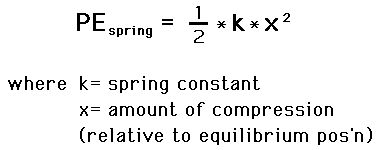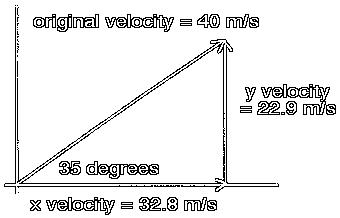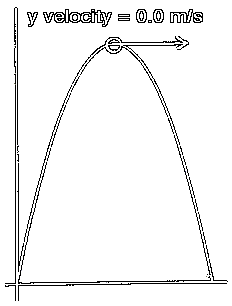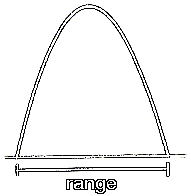- you cannot win (you can’t get something for nothing because matter and energy are conserved.
- You cannot break even (you cannot return to the same energy state because entropy always increases
- You cannot get out of the game (because absolute zero is not attainable).
My Physics Blog
Sunday, January 9, 2011
Three Laws of Thermodynamics
An easy and funny way to define the three laws of thermodynamics (by C.P. Snow, a British scientist and author):
Saturday, January 8, 2011
Wave Interference
Wave interference is the result of two or more waves meeting each other at one point and one time. As a result, one resultant wave is formed having the amplitude of the sum of all wave amplitudes interfering at this particular point. This is called the principle of superposition.
Constructive and Destructive interferences:
Basically, when the direction of waves are the same, the amplitude of the resultant wave will increase or build up because we're adding the amplitude of these waves. This is called Constructive interference.
Vice, versa, when the direction of waves are not the same, the amplitude of the resultant wave will be depended on the amplitude of these waves in different directions because they'll in some extent, cancels out each other's energy. This is called Destructive interference.
Here is an example illustrating both interferences:
Now, as to exactly how to draw the resultant wave, it also bothers me foir the fact that it's hard to imagine what the resultant wave will look like.There are multiple ways of how one can approach the question. For me,I would pick the method of finding the resultant amplitude at each point where more than two waves interfere with one another. At places where waves do not interfere with each other, the shape is then same as before, when they do interfere, simply find the resultant amplitude and keep note by drawing a note. Continue solving the problem in this matter from one end to the other. Once, no more interferences are left, we can simply connect the dots to produce the resultant wave.
Constructive and Destructive interferences:
Basically, when the direction of waves are the same, the amplitude of the resultant wave will increase or build up because we're adding the amplitude of these waves. This is called Constructive interference.
Vice, versa, when the direction of waves are not the same, the amplitude of the resultant wave will be depended on the amplitude of these waves in different directions because they'll in some extent, cancels out each other's energy. This is called Destructive interference.
Here is an example illustrating both interferences:
Now, as to exactly how to draw the resultant wave, it also bothers me foir the fact that it's hard to imagine what the resultant wave will look like.There are multiple ways of how one can approach the question. For me,I would pick the method of finding the resultant amplitude at each point where more than two waves interfere with one another. At places where waves do not interfere with each other, the shape is then same as before, when they do interfere, simply find the resultant amplitude and keep note by drawing a note. Continue solving the problem in this matter from one end to the other. Once, no more interferences are left, we can simply connect the dots to produce the resultant wave.
Wednesday, December 8, 2010
Types of Energy
Chemical energy
Chemical energy is basically the enrgy that is stored in molecular bonds, for example carbohydrate or the food we eat everyday. When a chemical reaction occurs, it converts other types of energy into chemical energy. Releasing chemical energy means that the energy from the molecular bonds is released, this is an exotermic chemical reaction. Absorbing chemical energy means that more energy is stored in bonds of molecules. In another sense, chemical energy is also stored energy, or potential energy.
The process of photosynthesis converts light energy into chemical energy in carbohydrate molecules. Living organisms like you and me use this form of energy for food and metabolism. Yet, this energy is usually stored in the bonds of our molecules and compounds. Over a long period of time, this stored energy is released by living cells by a process called respiration. When this occurs, chemical energy is again converted into other types of energy, such as kinetic energy used for movement, or heat energy to keep our body warm.
Gravitational Potential Energy
 For all objects on Earth, gravitatonal potential energy acts on them because it is postioned within the gravitational field. Therefore, when an object is elivated at certain height, we can say that there are gravitational potential energy stored in the object because the energy is stored within the object and has the potential to be released. The potential energy at height h is equal to the work required to elivate the object. Since the force required to lift the object is equal to its weight, therefore gravitational potential energy is equal to weight times the height. In a simple example, if you lift an object, such as your shoe to a certain height, work is being done because a force was applied and there was a displacement. Now you've lost some energy having to lift the shoe, but we know that energy cannot be destroyed or created. Therefore, the chemical energy you used which was converted into kinetic energy in the movement of muscles or finally converted into gravitational potential energy. Once you let go of the shoe, the shoe would fall wouldn't it? Then again the gravitational potential energy stored in the shoe is again converted back into kinetic energy.
For all objects on Earth, gravitatonal potential energy acts on them because it is postioned within the gravitational field. Therefore, when an object is elivated at certain height, we can say that there are gravitational potential energy stored in the object because the energy is stored within the object and has the potential to be released. The potential energy at height h is equal to the work required to elivate the object. Since the force required to lift the object is equal to its weight, therefore gravitational potential energy is equal to weight times the height. In a simple example, if you lift an object, such as your shoe to a certain height, work is being done because a force was applied and there was a displacement. Now you've lost some energy having to lift the shoe, but we know that energy cannot be destroyed or created. Therefore, the chemical energy you used which was converted into kinetic energy in the movement of muscles or finally converted into gravitational potential energy. Once you let go of the shoe, the shoe would fall wouldn't it? Then again the gravitational potential energy stored in the shoe is again converted back into kinetic energy.Elastic Potential Energy
When an elastic material, such as a spring is stretched, we're again storing potential energy in the spring. Other elastic materials, such as rubber band, trampolines, bows and arrows all can store potential energy when they're stretched from its original form.Furthermore, it's only common sense that the more we stretch, the more potential energy is stored.
When there are no potential energy stored in an elastic, we say that its at rest or its equilibrium position. In this position, no force is applied to to stretch the elastic to store potential energy in them.How we measure the relative elastic potential energy stored within an elastic is by how much it is stretched from its equilbrium position, formed by equation:
Mechanical Kinetic Energy
Whenever work is done by force, whether supplied from energy such as chemical energy from food or other sources of potential energy, the object work is done upon acquires mechanical energy. Thus mechanical energy can be both kinetic or potential energy. In other words, mechanical energy can be resulted from an object's motion (kinetic energy) or its stored energy position (potential energy). Think about car engines, pulleys, cannons, all these things are machines used to do work. Therefore, another way of looking at mechanical energy is the energy that supplies an object to do work. Since energy cannot be destroyed or created, mechanical energy must be first be converted from another energy source. Think about a pitcher in a baseball game, when the ball is pitched, it is doing work by travelling a distance at a high velocity. The mechanical energy in the ball however, was converted from the kinetic energy from the pitcher's arm muscles.
Another illustration of mechanical energy:
 Thermal energy comes from heat produced by any kind of source, such as fire. This form of energy is created due to the increased activity or velocity of molecules in a substance. We generally feel thermal energy as something that is too cold or too hot for our comfort. This is because the velocity of the movement of molecules of the substance is either moving too fast or too slow for our body's comfort. Temperature however, is a relative measure of the amount of kinetic energy stored in molecules in a substance. For thermal energy, again the laws of conservation of energy applies. The laws of thermodynaics explains that thermal energy can be exchanged from one object to another.For instance, heating up a bucket of water will cause the water molecules to faster and thus boil.However, this energy that water acquired over the period of heating was not created, it was received from the energy of the heater, which lost the same amount of energy that water gained.
Thermal energy comes from heat produced by any kind of source, such as fire. This form of energy is created due to the increased activity or velocity of molecules in a substance. We generally feel thermal energy as something that is too cold or too hot for our comfort. This is because the velocity of the movement of molecules of the substance is either moving too fast or too slow for our body's comfort. Temperature however, is a relative measure of the amount of kinetic energy stored in molecules in a substance. For thermal energy, again the laws of conservation of energy applies. The laws of thermodynaics explains that thermal energy can be exchanged from one object to another.For instance, heating up a bucket of water will cause the water molecules to faster and thus boil.However, this energy that water acquired over the period of heating was not created, it was received from the energy of the heater, which lost the same amount of energy that water gained.Sound Energy
When we pluck the strings on a guitar, or smack the surface of a drum, we hear a sound or music if we're really good at playing these instruments. In turn, we have also created a type of energy as we hear the music. Sound energy is the energy produced by vibrations travelling through the environment, or a medium. This vibration causes waves of pressure which lead to some level of compression and rarefaction in the environment that it's travelling in. So one may ask: what type of energy is sound energy? Well, it's obviously not chemical energy since the energy is not stored in any bonds of molecules. It's not gravitational energy nor thermal energy. Becauuuuuuuuuuuuuse: sound is a form of MECHANICAL energy! However, sound energy is not used to do the amount of work human requires from machine because the amount of energy gained from sound is usually very small.

Tuesday, November 30, 2010
Cannons
So hard to find any background on this topic, so I did not find much helpful information beside the obvious...
There are few factors that I think will determine the effectiveness of the cannon.
First factor: Angle for the maximum range
In a hypothetical situation, suppose all other factors are controlled, including friction, air resistance, velocity, etc. And the only variables that are being altered is the launching angle of the cannon, how will the range of the cannon ball launched be affected? Or otherwise, what angle will give the biggest maximum range for this projectile motion of cannon?
It seems that the launch angle of 45 will result the farthest distance travelled. From what we learned in kinematics, range of a projectile motion will be determined by the product of hang time and Vx. For angle of 30, it had the biggest value for Vx out of the 3 cases, but it's maximum range was limited by its hangtime due to lack of Vy. For angle of 60, it had the biggest value for Vy. Therefore, its hangtime was the greatest out of all three, however, its maximum range was then limited by its Vx, the lowest of all 3. The angle of 45, which did not have the highest value in any categories, had the biggest maximum range because it had a decent value for both the hangtime and also Vx.
Tight Sealing:
For the duct tape that are used to stick together the pieces of pop can, it ensures that first of all, fuel does not leak when we shake the cannon, and secondly to make sure the no force/energy caused by the explosion "escape" from the launch. This is because we want the force caused by the explosion to focus on the "bullet", which would be the paper cup.
Mass of the base:
The mass should not be too light, because the force that causes the cannon ball to fly on its path will cause an equal force on the base of the cannon (opposite force, newton's 3rd law).This is why tanks and cannons are made out of metal as its for resisting the opposite force after launching.
There are few factors that I think will determine the effectiveness of the cannon.
First factor: Angle for the maximum range
In a hypothetical situation, suppose all other factors are controlled, including friction, air resistance, velocity, etc. And the only variables that are being altered is the launching angle of the cannon, how will the range of the cannon ball launched be affected? Or otherwise, what angle will give the biggest maximum range for this projectile motion of cannon?
 | ||
| Imagine launching at 30, 45 and 60. |
Tight Sealing:
For the duct tape that are used to stick together the pieces of pop can, it ensures that first of all, fuel does not leak when we shake the cannon, and secondly to make sure the no force/energy caused by the explosion "escape" from the launch. This is because we want the force caused by the explosion to focus on the "bullet", which would be the paper cup.
Mass of the base:
The mass should not be too light, because the force that causes the cannon ball to fly on its path will cause an equal force on the base of the cannon (opposite force, newton's 3rd law).This is why tanks and cannons are made out of metal as its for resisting the opposite force after launching.
In summary, what will make a better cannon? A combination of high hang time, initial horizontal velocity, little friction and built almost flawlessly.(Completely enclosed taping, a strong base and other factors)
Wednesday, November 24, 2010
Dynamics
Equilibrium
This is achieved when the forces of both x and y components are balanced. Therefore, we get an overall acceleration of 0, hence the object is at a state of rest.
Assumptions:
For example:
Object B has a force of 9.2N acting on it at a angle of 70 degrees with the horizontal, therefore
Bx = 9.2 cos 70
By = 9.2 sin 70
With multiple forces acting on an object, add my x directions forces and y direction forces together to get Fnetx and Fnety.
The other forces acting on the object would be gravity. Since the forces are balanced and the object is not moving up and down, we can conclude that:
Fg = F net y, furthermore, we know that Fg = ma.
We already know that a is equal to 9.81m/s^2, therefore the mass of the object can be calculated by:
M = F nety / acceleration.
We can always check if our answer is right by calculating and see if the x direction forces are balanced as they're suppose to in an equilibrium.
Static Inclines
Assumptions:
Fgx=fs, where Fgx = Mg sin θ => Mg sin θ = M Fn
Fn=Fgy, where Fgy = Mg cos θ => Mg cos θ = Fn (sub into first equation)
Mg sin θ = µ Mg cos θ
µ = sinθ/cosθ
µ = tanθ
Kinetic Incline
In this case, the incline is almost like a static incline, except the object is moving and accelerating in the x direction. Therefore, ax does not = 0
Other assumptions:
Fgx - fk = ma, Mg sin θ- µFn = Ma (1)
In the y direction:
Fn - Fgy = 0 (since acceleration is still 0), Mg cos θ = Fn (2)
Sub (2) into (1)
Mg sin θ- µ Mg cos θ= Ma
a = Mg sin θ- µ Mg cos θ / M
Pulleys
Assumptions:
For m1:
*sometimes pulley will not necessarily be parallel to each other, they could be perpendicular or at any angle
Trains:
Assumptions:
For m1:
F = ma
Fₓ = m1aₓ
This is achieved when the forces of both x and y components are balanced. Therefore, we get an overall acceleration of 0, hence the object is at a state of rest.
Assumptions:
- No Friction
- No Acceleration
For example:
Object B has a force of 9.2N acting on it at a angle of 70 degrees with the horizontal, therefore
Bx = 9.2 cos 70
By = 9.2 sin 70
With multiple forces acting on an object, add my x directions forces and y direction forces together to get Fnetx and Fnety.
The other forces acting on the object would be gravity. Since the forces are balanced and the object is not moving up and down, we can conclude that:
Fg = F net y, furthermore, we know that Fg = ma.
We already know that a is equal to 9.81m/s^2, therefore the mass of the object can be calculated by:
M = F nety / acceleration.
We can always check if our answer is right by calculating and see if the x direction forces are balanced as they're suppose to in an equilibrium.
Static Inclines
Assumptions:
- No acceleration
- + tive axes in the direction acceleration
- No air resistance
- fs (static friction) = µ * Fn
- Fn is perpendicular to the surface
Fgx=fs, where Fgx = Mg sin θ => Mg sin θ = M Fn
Fn=Fgy, where Fgy = Mg cos θ => Mg cos θ = Fn (sub into first equation)
Mg sin θ = µ Mg cos θ
µ = sinθ/cosθ
µ = tanθ
Kinetic Incline
In this case, the incline is almost like a static incline, except the object is moving and accelerating in the x direction. Therefore, ax does not = 0
Other assumptions:
- No acceleration in y direction
- + tive axes in the direction acceleration
- No air resistance
- fk (kinetic friction) = µk * Fn
- Fn is perpendicular to the surface
Fgx - fk = ma, Mg sin θ- µFn = Ma (1)
In the y direction:
Fn - Fgy = 0 (since acceleration is still 0), Mg cos θ = Fn (2)
Sub (2) into (1)
Mg sin θ- µ Mg cos θ= Ma
a = Mg sin θ- µ Mg cos θ / M
Pulleys
Assumptions:
- No friction from pulley, rope or any other materials in the system
- no air resistance
- Remember to draw multiple FBDs depending on situation
- Always make acceleration the positive axes in all FBDs
- T1=T2
- acceleration of the system is the same
For m1:
F = ma
Fₓ = ma
Fₓ = 0
Fy = m1ay
m1g - T = m1a
T = m1g - m1a (1)
For m2:
F = ma
Fₓ = ma
Fₓ = 0
Fy = m2ay
T - m2g = m2a
T = m2a + m2g (2)
By comparing equation (1) and (2)
set (1)=(2)
m1g - m1a = m2a + m2g
m1g - m2g = m2a + m1a
m1g - m2g = a (m2 + m1)
(m1g - m2g) / (m2 + m1) = a
To Find T
Sub the value of a into equation 1 or 2 to get value for T*sometimes pulley will not necessarily be parallel to each other, they could be perpendicular or at any angle
Trains:
Assumptions:
- 1 FBD for acceleration of the whole system, where a is constant throughout the system
- multiple FBDs depending for the number of tensions there are
- ay = 0
- no air resistance
- weightless cables
- + axes in direction of a
For system acceleration:
F = ma
Fₓ = maₓ
Fₐ - f = maₓ
Fₐ - µmg = maₓ
aₓ = (Fₐ - µmg) / m
This acceleration will be same for all parts of the train. There's no acceleration in y component since we do not see the train going up and down. This is the same for all components of the train
For m1:
F = ma
Fₓ = m1aₓ
Fₐ - T1 - f1 = m1aₓ
Fₐ - T1 - µm1g = m1aₓ
Fₐ - T1 - µm1g = m1aₓ
T1 = Fₐ - µmg - m1aₓ
Now there's a choice of using m3 or m2, but I think Mr. Chung said using m3 is suppose to be less likely to make a mistake. So for the sake of grade, we should stick with m3
For m3:
F = ma
Fy = m3ay
Fy = 0
Fn3 - m3g = 0
Fn3 = m3g
Fₓ = m3aₓ
T2 - f3 = m3aₓ
T2 = m3aₓ + f3
T2 = m3aₓ + µm3g
Saturday, November 6, 2010
Projectile Motion
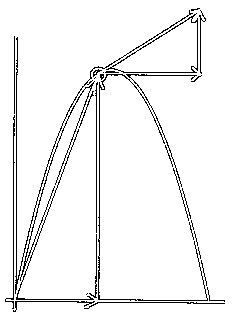 |
| Projectile Motion |
A general summary of solving projectile motion problems, finding the usual things (Range, Height, hang time), without regard of air resistance.
Since all these problems occur on Earth, the acceleration of all the problems will be the gravity (-9.8m/s2)
However, gravity will only affect the vertical-y component, therefore the acceleration of horizontal speed is 0 - constant velocity (v1x = v2x = vx)
Components of original velocity:
Using basic trignometry, we can calculate x and y components when given the inital velocity and angle.
X component of original velocity: vx1 = v cos(θ)
Y component of original velocity: vy1 = v sin(θ)
Height:
At its maximum height, Vy becomes 0
Given vy2 = 0, vy1 = V1 sin θ, ay = -9.8m/s2
v22=v12+2ad
v22=v12+2aH
0=v12-2gH
H=v12/2g
Hang Time: After finding out V1x and V1y with trignometry, we know that the displacment vertically is 0 after the total time.
Given : dy = 0, ay = -g
d = v1t + 0.5at2
0 = v1yt + 0.5(-g)t2
v1yt -0.5gt2=0
t(v1y-0.5gt)=0
Therefore, t = 0 or T = 2v1y/g
Range:This is the distance the object travelled horizontally, since the horizontal velocity is constant, we can find out the distance from equation :
Dx = (Vx)(T)
With reference to the time of the projectile, we can then easily calculate the range.
(I prefer doing them one by one)
Different Types of Projectile Motion
Tuesday, November 2, 2010
The Physics behind Roller Coasters
Many people do not realize the force driven behind rolle coasters is not from electric energy, but potential and kinetic energy. The mechanism of roller coasters is all about the physics behind the energy from its motions.
Think about when you lift a textbook above the table, what is happening to the book? It's actually gaining potential energy because when the book is dropped at some point, the energy can be observed and heard when the book hits the table. This is all because another force - gravity, is acting on the object. Relate this observation to rollercoasters, the potential energy of the rollercoaster will be highest when it's at the highest peak of the rail, because more kinetic energy will be produced when it swoshes down the rail. Therefore, as the coaster travels lower and lower, it converts all of its potential energy into kinetic energy. So the potential energy is the lowest when its at a low altitude, but inversely, kinetic energy is the highest.
Modern roller coasters usually have a launcher, which gives it an extra push to begin with, building up more kinetic energy.We know that energy cannot be created or destroyed, rollercoasters work on the principles of the conversion of one form of energy into another. However, in theory, the train should be able to climb to its original height after the first drop (energy conversion). But dissipative forces such as friction and air resistance denies this possiblity. This is why the first peak for a rollercoast is always the highest in order for it to gain more potential energy.
Subscribe to:
Posts (Atom)



